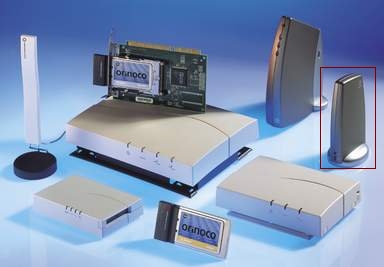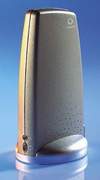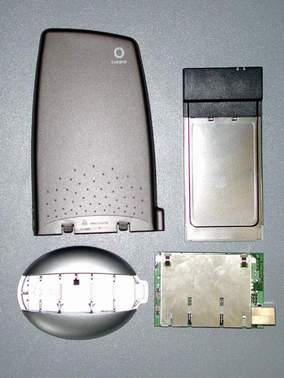We wrote about the products for building wireless networks of the IEEE
802.11b standard many times already. For the most part they were adapters
for the PCMCIA/PC Card bus convenient for utilization in notebooks. And
when used in desktop PCs, they required additional controllers.
The most successful solution of this problem is building of a controller
for the USB bus. Since the data rate is some 11Mbit/sec, the USB bus, being
standard for desktop PCs, with its 12Mbit/sec bandwidth and a possibility
to power the device is best suitable for this purpose.
Today we will take a close look at the Lucent
ORiNOCO USB Client Silver wireless adapter,
or IEEE 802.11b controller for the USB bus. Wireless products from Lucent
are now produced under the trademark Agere
Systems, but products are labeled as being from Avaya
Communication. That's a knotty case, but for a user the most important
thing is that all the products are developed by Lucent in order to have
good quality and perfect feature support.
This adapter excellently supplement the Lucent ORiNOCO series that consists
of PC Card adapters (for notebooks and PDAs), ISA/PCI adapters (for PCs),
Access Points (for connection to a wired network), external antennae:

The specification of the device almost coincide with the characteristics
of the PCMCIA brothers:
- IEEE 802.11b standard, Wi-Fi
- FR: 2400-2500 MHz
- Frequency channels: 11
- Speeds: 11, 5.5, 2, 1Mbit/sec
- 64 and 128 bit (in "Gold" version) WEP coding support
- Distance of operation:
| |
11 Mbit/s |
5.5 Mbit/s |
2 Mbit/s |
1 Mbit/s |
| Open Office |
160 m
|
270 m
|
400 m
|
550 m
|
| Semi Open Office |
50 m
|
70 m
|
90 m
|
115 m
|
| Closed Office |
25 m
|
35 m
|
40 m
|
50 m
|
- Output power: 15 dBm
- External interface: USB 1.1

The differences consist primarily in the dimensions and power consumption:
- dimensions: 63X89X145mm
- weight: 170g
- power consumption: Doze mode 10 mA, Receiver mode 245 mA, Transmit mode
360 mA
As well as in the software support, which is presently given only in the
Windows 98/ME/2000.
The device ships in a small box which contains also a description, a
CD with drivers, programs and additional documentation and a USB cable
1m long.
The adapter is not a completely new development, it is a usual ORiNOCO
PC Card Silver installed in the PCMCIA adapter for the USB bus:

In fact this technology is not new - the majority of Access Points for
wireless networks are built the similar way - they are microcomputers with
incorporated wireless cards of the PCMCIA standard. Such approach allows
for reducing time and funds for development, but the end cost of the product
increases.
The USB adapter from Lucent uses two chips from Cypress
Semiconductor: the EZ-USB FX controller CY7C64613 and a 32 KBytes
memory chip. The master chip combines a USB bus controller, a processor,
I/O lines. It is compatible with USB 1.1 and 2.0 standards, but you shouldn't
expect a high speed from the 24 or 48 MHz processor 8051. Note that it is
not allowed to use this USB controller separately from the PCMCIA card
Lucent.
The device is comparatively small, it is easy to be install on any surface,
though a USB cable is a bit short and can make problems when positioning
the adapter for obtaining the maximum connection quality. There are two
LEDs near the base. One indicates that the power is supplied to the device,
the second one shows the status of the wireless network. But the observation
shows that the first LED also changes its color during the network operation.
As you might remember, a PCMCIA adapter has two LEDs on its case as well.
But they are located inside in the USB version, as well as an output for
an external antenna - one can virtually make a hole in the case to bring
it here, but it isn't meant officially.
Installation of the adapter is very simple, the only unclear issue was
packed drivers for the Windows 2000, that is why first we had to install
them on a PC with a proprietary installation program. Replacement of an
out-of-order adapter makes some problems, since drivers get tied to a particular
adapter and, when it is to be changed, the drivers are also to be reinstalled.
It is said in the documentation. I tried to change a PCMCIA card in the
USB adapter, and I had only to reboot the Windows 2000, that is why this
problem might be artificial.
Since every USB port allows for a maximum of 500mA, the adapter taking
the rated 360mA should work flawlessly. But having checked into the USB
controller's properties how much the Lucent ORiNOCO USB consumes I saw
420mA. It is much more than specified in the documentation, but the controller
can set this figure with some reserve. By the way, a simultaneous operation
of the wireless adapter and a portable hard disc didn't cause any problems
despite the fact that their aggregate consumption made 520mA.
We have noticed no compatibility problems during the operation of the
device under the Windows 2000. Besides, the adapter can be switched on/off
without rebooting of the system. It seems that with USB support in Microsoft
operating systems everything is getting better: when disabling the adapter
in the Windows 98SE, the system hung, showed GPF etc.
Since the device is based on the same PCMCIA card,
such parameters as connection quality and operating distance do
not differ absolutely from the earlier
described adapters. The only interesting issue is speed. The
measurements show that the data rate is less than for the PCMCIA
card - approximately 600 KBytes/sec against 700 KBytes/sec. First,
it may be caused by the drivers. Today only the second version is
available, and we know that Lucent can increase the speed much in
the following versions. Secondly, it may be caused by the USB drivers
of the system (I used the Windows 2000 Pro). Since we know that
there are real devices working at 900 KBytes/sec via the USB (for
example, hard discs and CDRW drives), we should expect something
more from the Lucent ORiNOCO USB as well, but it might be that the
USB-PCMCIA adapter is itself a limiting factor.
Conclusion
The Lucent ORiNOCO USB Client Silver adapter is virtually the most beneficial
way for desktop PCs to be connected to a wireless network. First, it doesn't
require a PCMCIA-ISA/PCI controller. Secondly, it can be installed up to
10 m away from a PC (you need only a long USB cable which is much cheaper
than a high-frequency antenna cable, plus you don't need adapters); it
is very important for a right positioning of an antenna and for reaching
the maximum distance of operation of the card. Besides, the price is only
$10 higher than that of a PCMCIA card of the same manufacturer.
Highs:
- convenient connection to a PC via the USB bus
- relatively low price
Lows:
- data transfer rate lower than that of the PCMCIA wireless adapters
Write a comment below. No registration needed!



